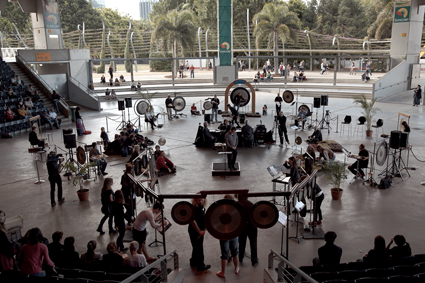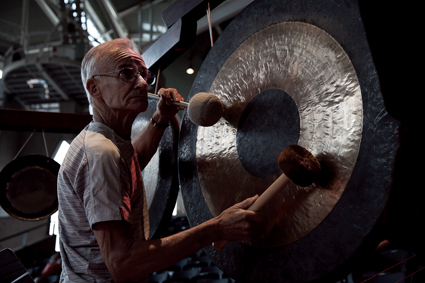 |
Australian Percussion Gathering, Brisbane photo courtesy of Qld Conservatorium, Griffith University |
Previously, I’ve heard its nonsense lines (“Fümms bö wö tää zää Uu”) delivered with a sense of comic attack or even aggressive ejaculation, but Schick soft-shuffled the floor in a thoughtful perambulation, the piece’s sound clusters driving a necessity to speak. Why does he speak? Why should we listen? These are questions Schick asks of every performance he gives. Here is a master musician plumbing a lifetime of emotions, experiences and ethical considerations, giving immense respect to his audience.
Schick’s Ursonate affirmed the voice (and lips, tongue and glottis) as an instrument equal to any of a percussionist’s tools, only perhaps more bared. Many of the Gathering’s master classes talked less of technique (“technique is merely the means,” insisted Sylvio Gualda) than of playing from your bones. Discussions centred on refining choices to do with aesthetics, timbrel groupings and the building of textures. Not every teacher said so baldly that you have to ‘play from yourself’ as did Phil Treloar, but with many it was implied—the Gathering’s strong emphasis on collaborative improvisation provided a context where, across the spectrum of ages and experience, people could plumb themselves.
 |
Barry Quinn, The Gathering photo courtesy of Qld Conservatorium, Griffith University |
But as Artaud wrote, “Being has teeth,” and ‘Being’ can be both encouraging and fierce. There was nothing quite like witnessing Sylvio Gualda (for whom Yannis Xenakis wrote his exacting percussion solos) demonstrate “not ffff [quadruple forte] but energy“ with barely a flick of his wrists. It was like the Concorde’s sonic boom at 10 paces within two seconds. Whilst Japan’s Kuniko Kato plays Xenakis taiko-like, a knife forcing silence out of sonic space, a contained Gualda holds this split-second ignition in his ribs.
Solo percussion in music of the classical tradition is a recent phenomenon, developing from the late 1920s works of Edgar Varese through John Cage to the contemporary environmentalist John Luther Adams. It was an honour to be in the room with master artists for whom many of the pieces performed were actually written. Especially moving was Schick’s bow to Sylvio Gualda as his tribal elder in the wings. This honouring of lineage was characteristic throughout the event.
It’s also an honour, always, to hear works made as we listen. Darryl Pratt and Phil Treloar exemplified this in their improvised duo, marimbas playing both sweet and dry, wiry and full of dew—a gracious marriage, despite the 20 year gap since their last playing together. Perhaps experience teaches skills of giving in.
But for Schick, repeating a work holds the same challenge—to make every time like the first. Here he performed Xenakis’ Psappha for the 250th time. ‘Fresh’ is not the word so much as volatile as gunpowder-in-waiting. Schick kicks the side drum like a tempestuous goat, obsessive, fixated and seething within the Sapphic cells of rhythmic measure that generate the piece. His master class gave techniques—layerings, placing, personal challenges—to keep one fresh and able to surprise oneself in performance.
In an evening concert, Varese’s monster masterpiece, Ionisation (1929-31) was performed twice, under two different conductors, providing another example of how to reignite an old flame. It highlighted the impact of interpretation, with huge differences of timbre and tone. But there were also quieter intimacies. Speak Percussion’s Eugene Ughetti performed a solo by choreographer Deborah Hay in a delicate, wiry, hiccupping and side-stepping dialogue between feet and floor, skin and space. He awaits the companions who never quite fall onstage from the wings. This was so poignant a performance that, although comic, no one laughed. Ughetti’s body dances like an amoeba yet we never lose sight of the fine musical choices with which he recites and drums the hand gong.
In Driftwood, Ughetti gently dismantled and recomposed a marimba like a father playing ‘toss’ with his child. He and Matthias Schack-Arnott kissed bows with their lips. This threshold of the lips was also, more explosively, explored by Schick in Touché by Globokar. Based on Brecht’s play Life of Galileo, the piece is a bravura, agon-like dialogue between voices of faith and fear, the yoked vocal consonants and paired glocks always threatening to break partnership with each other.
Among the students, Defying Gravity partnered in as sinuous and athletic a dance with marimba as if it had a skirt and legs (oh that keyboard girl!) and Ba Da Boom rumbled suitcases and tossed coins in the space. High school kids performed with aplomb. Rebecca Lloyd-Jones, Matthew Horsley, Cameron Kennedy and Robert Oetomo made outstanding contributions and were awarded special prizes.
Brisbane group Clocked Out continued their exploration of unusual sound and visual objects, and miniature toys. It was a pleasure to hear how Erik Griswold’s aesthetic has matured over the past decade. To end the conference, the full coterie of students, teachers and guests performed in the concrete circle of the SunCorp Plaza playing Michael Askill’s 1000 Gongs (how many moods can a gong make?—one thousand), a sequence of 14 improvisations which incorporated a massive two-metre diameter tam-tam, song, movement, spoken word, trumpets and water gongs in a two-hour ritual traversing words and tonalities from Marc Bolan to Yogi Bhajan, Messiaen to Stockhausen. Many of the general public who wandered in to the performance stayed the distance.
The final day saw a trip to the Sunshine Coast hinterland, to the Cooroora Institute run by Tamsin Kerr, Ross Annels and their daughter Anika, for a day of listening and playing in the rainforest. The primary tool here was communication between ear, heart and land. Convenor Vanessa Tomlinson wondered how everyone would respond.
A young woman suddenly starts walking on all fours, boots on her hands (becoming animal); a senior percussionist rustles a tree (becoming mantis); two young men rumble a dying branch to its sonic death. Drums become insects and call to invisible partners across the mountainside. A song is improvised beside a Bunyip’s waterhole. Jan Baker-Finch rustles her body like leaves, moving, being moved by the winds of other improvisers. We finish the day with mulled wine by the fire.
The Gathering, convenor Vanessa Tomlinson with Michael Askill and Tom O’Grady, Queensland Conservatorium, Griffith University, Aug 26-30
Zsuzsanna Soboslay was a guest of the Conservatorium, as writer for Real Time and participant/co-performer/dancer at the festival.
RealTime issue #99 Oct-Nov 2010 pg. 47
© Zsuzsanna Soboslay; for permission to reproduce apply to [email protected]








 back
back